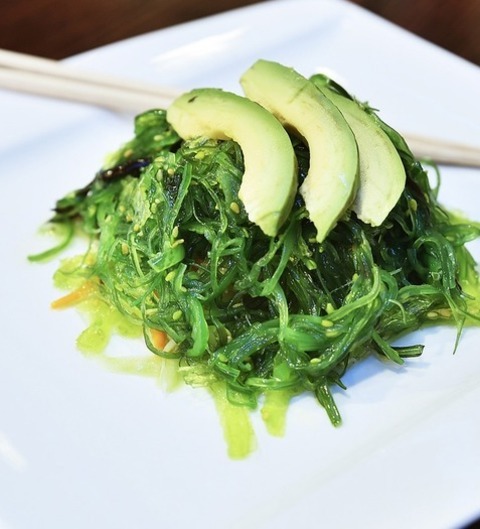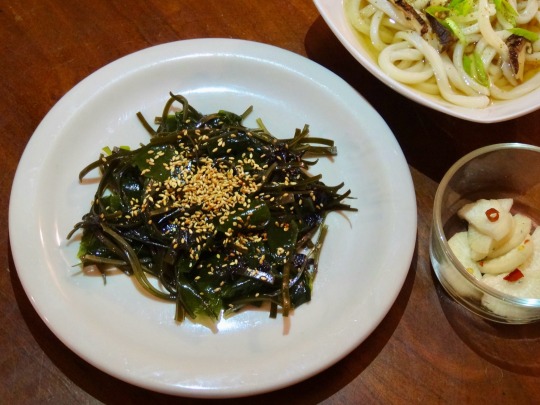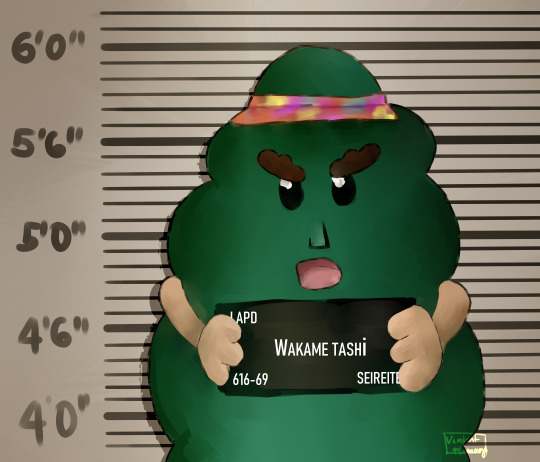#wakame seaweed
Explore tagged Tumblr posts
Text
Seaweed Salad Chuka Wakame Recipe

Seaweed Salad Chuka Wakame is a light and refreshing Japanese dish that can be served as a side dish or as a light meal. It's made with wakame seaweed, which is high in minerals and vitamins, and flavored with sesame oil, soy sauce, rice vinegar, and sugar. Made with Wakame Seaweed, Rice Vinegar, Soy Sauce, Black Pepper, Sesame Oil, Salt, Sugar, Sesame Seeds.
2 notes
·
View notes
Text
Salad Recipes

This Wakame Seaweed Salad with Avocado is a light lunch or side dish that is refreshing and healthy. The wakame seaweed and avocado combine to create a creamy texture, and the dressing adds a savory, slightly spicy flavor.
0 notes
Text
Seaweed Salad Chuka Wakame

Seaweed Salad Chuka Wakame is a light and refreshing Japanese dish that can be served as a side dish or as a light meal. It's made with wakame seaweed, which is high in minerals and vitamins, and flavored with sesame oil, soy sauce, rice vinegar, and sugar. Made from Wakame Seaweed, Rice Vinegar, Soy Sauce, Black Pepper, Sesame Oil, Salt, Sugar, Sesame Seeds.
0 notes
Text
Wakame Seaweed Salad with Avocado

This Wakame Seaweed Salad with Avocado is a light lunch or side dish that is refreshing and healthy. The wakame seaweed and avocado combine to create a creamy texture, and the dressing adds a savory, slightly spicy flavor. Made from Garlic Clove, Sesame Oil, Red Pepper Flakes, Honey, Wakame Seaweed, Soy Sauce, Rice Vinegar, Toasted Sesame Seeds, Avocado.
0 notes
Text
Wakame Seaweed Salad with Avocado Recipe

Wakame Seaweed Salad with Avocado. This Wakame Seaweed Salad with Avocado is a light lunch or side dish that is refreshing and healthy. The wakame seaweed and avocado combine to create a creamy texture, and the dressing adds a savory, slightly spicy flavor.
0 notes
Text
Recipe for Seaweed Salad Chuka Wakame

Made with Wakame Seaweed, Rice Vinegar, Soy Sauce, Black Pepper, Sesame Oil, Salt, Sugar, Sesame Seeds. Seaweed Salad Chuka Wakame is a light and refreshing Japanese dish that can be served as a side dish or as a light meal. It's made with wakame seaweed, which is high in minerals and vitamins, and flavored with sesame oil, soy sauce, rice vinegar, and sugar.
0 notes
Text
Wakame Seaweed Salad with Avocado - Salad Recipe

This Wakame Seaweed Salad with Avocado is a light lunch or side dish that is refreshing and healthy. The wakame seaweed and avocado combine to create a creamy texture, and the dressing adds a savory, slightly spicy flavor. Made with Garlic Clove, Sesame Oil, Red Pepper Flakes, Honey, Wakame Seaweed, Soy Sauce, Rice Vinegar, Toasted Sesame Seeds, Avocado.
0 notes
Text
Wakame Seaweed Salad with Avocado Recipe

Wakame Seaweed Salad with Avocado. This Wakame Seaweed Salad with Avocado is a light lunch or side dish that is refreshing and healthy. The wakame seaweed and avocado combine to create a creamy texture, and the dressing adds a savory, slightly spicy flavor.
0 notes
Text
Sushi dinner from Sushi GoGo (争鲜gogo) located at Woodlands MRT Station. Took a fancy to this Truffle & Spicy Mixed Bento (S$6) which came with four salmon gunkan maki, two scallop and prawn sushi in two flavours topped with wakame. Aburi Salmon Bento (S$6.50) is my favourite but this set looks dehydrated.


#Sushi Express#争鲜#Sushi GoGo#争鲜gogo#Takeaway#Packed#Sushi#Truffle & Spicy Mixed Bento#Gunkan Maki#Salmon#Scallop#Prawn#Mayo#Truffle#Wakame#Seaweed#Chilli#Sauce#Tobiko#Flying Fish Roe#Aburi Salmon Bento#Torched#Seared#Sesame Seeds#Sushi rice#Japanese#Food#Buffetlicious
106 notes
·
View notes
Text

Wakame
“Undaria pinnatifida is a brown seaweed that reaches an overall length of 1-3 m. Undaria is a native of the Japan Sea and the northwest Pacific coasts of Japan and Korea. In Japan, Undaria, known locally as 'wakame', is extensively cultivated as a food plant. Japanese consumption of the alga is around 200,000 tonnes of fresh or dried plant per annum. Undaria is regarded as a pest because it is highly invasive, grows rapidly and has the potential to overgrow and exclude native seaweeds. It was first detected in Australia in 1988 near Triabunna on the east coast of Tasmania. Over the following ten years it spread along 100 kms of the Tasmanian east coast and also to Victoria - the most likely vector being international shipping.” - via Wikimedia Commons
#wikipedia#wikipedia photos#submission#wakame#seaweed#nature#sea#ocean#plants#underwater#Undaria pinnatifida#wikipedia pictures#botany#marine biology#wikimedia commons#undaria#marine plants#oceancore#ocean aesthetic#marine aesthetic#marine life#ocean life#sea life#brown seaweed#japan sea#pacific ocean#ocean plants
59 notes
·
View notes
Text
Got a red bean tea chuhai and my otoshi was a little veggie dish! The slimy stuff is called mekabu, which until recently I thought was a type of sea vegetable. And it is, I wasn't exactly wrong, but it turns out that it's actually just the flowering part of plain old wakame seaweed! The texture is so different that I never realized.
There's a lot of slimes in the Japanese diet. Some of them are nice, like this one! The flavor goes well with the sweetness of the vinegared carrots and cukes. And slime is supposed to have good properties not only for anti-aging but also chronic pain! At least according to the local conbini mama, who is always in my business. And I do trust her implicitly, for whatever reason 😂
24 notes
·
View notes
Text


[ID: First photo shows a mixed seaweed salad topped with toasted sesame seeds; in the background are bowls of pickled daikon and kake udon. Second photo is a close-up showing light shining through the seaweed. End ID]
わかめと昆布サラダ / Wakame to konbu sarada (Seaweed and kelp salad)
A wide variety of seaweed-based salads are made by Japanese home cooks. They may contain only a mix of seaweeds and a dressing, but may also feature vegetables including cucumber, carrots, lotus root (レンコン / はす), daikon (だいこん), corn, edamame (枝豆), or onion. Dressings are as varied as cooks, and may be based around sesame oil (ごま油), rice vinegar (米酢), miso paste (みそ / 味噌), ponzu sauce (ポン酢), or mayonnaise (マヨ).
This recipe is a good way to use up reconstituted kombu and wakame that were steeped to make soup stock. It includes instructions for two dressings: one based on rice vinegar and sesame oil, and another with a sesame-mayo base.
"わかめ" or "ワカメ" ("wakame") is likely from "若" ("waka," "young") + "海布" ("me," "seaweed"); it is a particular species of edible seaweed (Undaria pinnatifida) that is farmed in Japan, Korea, and China. It is sometimes called "sea mustard" in English. Without further specification, "wakame" in a culinary context is taken to mean the leaves of the seaweed; these are the same leaves that are eaten in miso soup (みそ汁).
The etymology of "昆布" ("kombu" or "konbu") is unknown. It may be a phonetic Japanese reading of the Middle Chinese "昆布" (Mandarin: "kūnbù") (itself from "綸布" "*krūn pās," "green ribbon" + "cloth"), used to refer to various types of kelp and seaweed. In Japanese, the term refers to any of a few species of edible kelp from the Laminariaceae family.
Dried kombu is steeped to make one type of dashi ("出汁" / "だし"), a stock that is used in various soups and sauces. Once reconstituted, it may be steeped again to make 二番だし ("niban dashi," "second dashi"), sliced and simmered as one ingredient in a 煮物 ("nimono," simmered dish), or roasted and combined with other seaweeds and spices to make 振り掛け ("furikake").
"サラダ" ("sarada") is probably derived from the English "salad."
Note that the "seaweed salad" served at Japanese restaurants in the U.S. is not commonly eaten in Japan. It is shipped out to restaurants and stores pre-packaged, and is made with colored オゴノリ ("ogonori"; "agar" on ingredients lists), きくらげ ("kikurage"; "wood ear mushroom" or "fungus" on ingredients lists), and byproducts of wakame including 茎わかめ ("kukiwakame," wakame stem) and メカブ ("mekabu," wakame sprouts; both listed as "wakame" or "seaweed" on ingredients lists). You may be able to find this salad in the freezer section of your local Asian grocery store. If you want to approximate the texture of this salad at home, try buying some mixture of ogonori, kikurage, kukiwakame, mekabu, モズク ("mokuzu"), and/or ひじき ("hijiki"). Instructions for the dressing are below.
Recipe under the cut!
Patreon | Paypal | Venmo
Ingredients:
For the salad:
2 cups total reconstituted kombu, wakame, hijiki, or other kelp or seaweed
Vegetable additions to seaweed salads are possible and common. Try adding some cucumber, julienned carrots, sliced lotus root, sliked daikon radish, corn, edamame, or sliced onion that's been soaked in plum vinegar for 15 minutes.
If you're including cucumbers, slice them, salt them, allow them to drain in a colander for about 10 minutes, then gently squeeze them of excess liquid, to avoid making your salad watery.
For dressing 1:
1 Tbsp unseasoned rice vinegar (米酢)
1 Tbsp toasted sesame oil (煎りごま油)
1/2 kosher salt
1/2 tsp vegetarian granulated sugar
1/2 tsp Japanese soy sauce (しょうゆ / 醤油) (such as Kikkoman's)
2 tsp toasted sesame seeds (いりごま)
To make U.S. restuarant-style seaweed salad, omit the soy sauce; replace the sugar with high fructose corn syrup; and add a pinch of cayenne pepper, 1/4 tsp of onion powder or yeast extract, and a pinch of MSG.
For dressing 2:
2 Tbsp vegan mayonnaise
1/2 tsp unseasoned rice vinegar (米酢)
1/4 tsp dried ground shiitake mushroom, or vegetarian dashi powder
1/4 tsp vegetarian granulated sugar
Drop of djion mustard
Pinch kosher salt
1 tsp Japanese soy sauce (しょうゆ / 醤油) (such as Kikkoman's)
Drizzle of mirin (みりん)
2 tsp toasted sesame seeds, ground in a mortar and pestle or spice mill
If you eat eggs, you can replace the first five ingredients with 2 Tbsp Kewpie mayo (キューピーマヨ).
For a halal version, replace the mirin with an extra pinch of sugar.
Instructions:
For the salad:
1. Slice kombu into very thin strips. Slice wakame into thin strips, or leave as-is, as desired. Slice other flat dried seaweed into thin strips or bite-sized pieces.
For dressing 1:
1. Whisk all ingredients except sesame seeds together in a small bowl. Toss with seaweed. Top with sesame seeds and serve cold.
For dressing 2:
1. Whisk all ingredients together in a small bowl. Toss with seaweed. Serve cold.

81 notes
·
View notes
Text
#2633 - Undaria pinnatifida - Wakame

AKA sea mustard, qúndài cài (裙带菜) or hǎidài yá (海帶芽), fougère des mers, and miyeok.
A brown alga native to rocky shores of the NW Pacific, and cultivated there since the 8th century, but now a seriously invasive species in many other temperate parts of the world, although in some of those areas it's still collected as food.
Usually eaten in soups and salads.
Timaru, Aotearoa New Zealand
#new zealand seaweed#wakame#undaria#alariaceae#kelp#invasive species#introduced species#actual sea weed#brown alga
7 notes
·
View notes
Text

Rehydrated back to its habitat
#abunaday#daily#bun#bunny#doodle#seaweed water#rehydrated seaweed#wakame#natural habitat#一日一兔#海苔#泡發海苔#吸水膨脹
7 notes
·
View notes
Text
having crohns sucks. having one of ur fav foods as a trigger for that crohns SUCKS
2 notes
·
View notes

